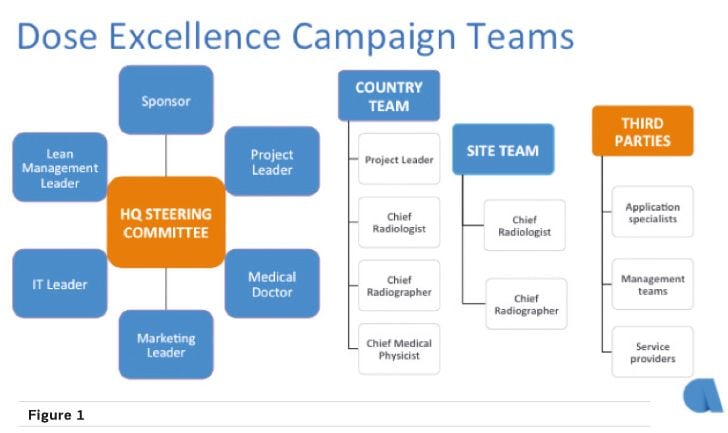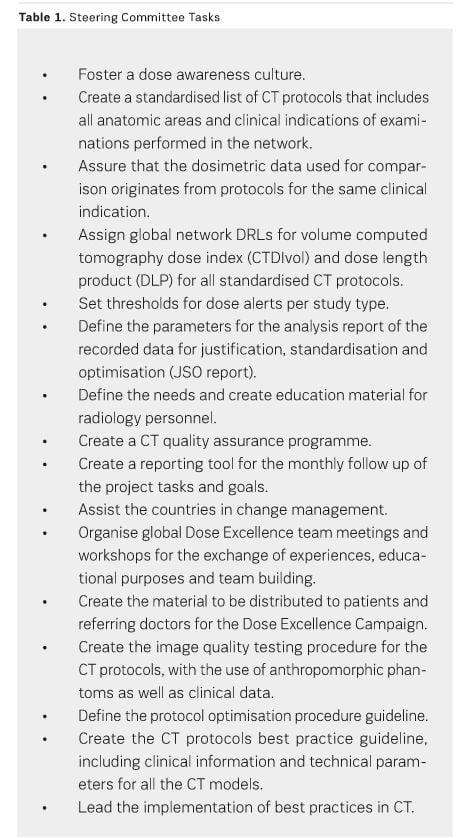HealthManagement, Volume 15 - Issue 4, 2015
- Make dose awareness a habit;
- Educate radiology personnel, patients and referring clinicians;
- Track, record and analyse CT dosimetric data;
- Justify and minimise the number of high-level dose examinations;
- Standardise and optimise CT protocols and practice;
- Create global network CT Dose Reference Levels (DRLs);
- Promote best practices in CT;
- Comply to the EURATOM 2013/59 Directive (Council Directive 2013).
Materials
- 7 countries: greece, Hungary, Italy, Poland, Portugal, Romania, Switzerland
- Number of multiple detector computed tomography (MDCT) scanners: 39
- CT vendors: Vendor 1 - 82%, Vendor 2 - 13%, Vendor 3 - 5%
- CT scanners: 6 to 128 detector rows
- MDCT models: 17
- MDCT scanners with dose reduction algorithm: 28
- Dose tracking software
Methodology
I. Human Resources

II. Steering Committee Role

III. Software to Track, Archive, Report and Analyse Dosimetric Data
- Detailed acquisition parameters and dose report for each patient study.
- Database export in Microsoft Excel format for further handling.
- Automated monthly reports that are sent via email.
- Automated alerts for high-level dose studies that assist in the fostering of dose awareness of the CT operators. The system provides a justification process for the alerts that allows the users to assess the centring of the patient, the function of the current modulation and the recording of the cause that produced the alert.
IV. Country/Site initiation process
Results
- Each National Health System’s rules and country legislation. For instance, the variations between countries in the reimbursement system that affects the frequency of examinations; the referral criteria that affect the imaging modality choice.
- Differing perceptions of radiologists, referring physicians and patients of CT dose, between countries.
- Differences in workload, study types and patient’s condition between private diagnostic centres and public and/or private hospitals.
- Differences in mentality between the generations of radiologists and radiographers.
- Records and analyses the percentage of alerted high-level dose studies and the percentage of justified alerts;
- Records and analyses the percentages of examinations performed according to the Standardised CT protocols list rules;
- Records and analyses the percentage of protocols performed that are above, within or below the DRLs.
Conclusion
Key Points
- The amount of ionising radiation exposure from CT is increasing, and there is great variability between patients and geographies for similar examinations.
- A rational strategy is required to both reduce and standardise patient dose over the full range of examination types.
- Affidea, a pan-European medical imaging services provider, has implemented a Dose Excellence Campaign across 7 European countries, involving approximately 190 people.
See Also: Radiation Dose: Communicating with Patients
See Also: Putting Quality and Safety for Patients First: ESR EuroSafe Imaging
See Also: Quality and Safety in Radiology: A Symbiotic Relationship
References:
Council Directive (EC) 2013/59/EURATOM of 5 December 2013 laying down basic safety standards for protection against the dangers arising from exposure to ionising radiation, and repealing Directives 89/618/Euratom, 90/641/ Euratom. [Accessed: 14 October 2015] Available from eur-lex.europa.eu/legal-content/EN/ ALL/?uri=CELEX:32013L0059
Fazel R, Krumholz HM, Wang Y et al. (2009) Exposure to low-dose ionizing radiation from medical imaging procedures. N Engl J Med. 361: 849-57.
Radiologyinfo.org (2011) What are the benefits of CT scans? [Accessed: 14 October 2015] Available from radiologyinfo.org/en/info. cfm?pg=safety-hiw_04



